Related Research Articles

The Reconstruction era was a period in United States history following the American Civil War, dominated by the legal, social, and political challenges of abolishing slavery and reintegrating the former Confederate States of America into the United States. During this period, three amendments were added to the United States Constitution to grant equal civil rights to the newly freed slaves. Despite this, former Confederate states often used poll taxes, literacy tests, and intimidation to control people of color.

Red River Parish is a parish located in the U.S. state of Louisiana. As of the 2020 census, the population was 7,620, making it the fourth-least populous parish in Louisiana. The parish seat and most populous municipality is Coushatta. It is one of the newer parishes, created in 1871 by the state legislature from parts of Bienville, Bossier, Caddo, Desoto and Natchitoches Parishes under Reconstruction. The plantation economy was based on cotton cultivation, highly dependent on enslaved African labor before the American Civil War.

Grant Parish is a parish located in the North Central portion of the U.S. state of Louisiana. As of the 2020 census, the population was 22,169. The parish seat is Colfax. The parish was founded in 1869 during the Reconstruction era.

Coushatta is a town in, and the parish seat of, rural Red River Parish in north Louisiana, United States. It is situated on the east bank of the Red River. The community is approximately 45 miles south of Shreveport on U.S. Highway 71. The population, 2,299 at the 2000 census, is nearly two-thirds African American, most with long family histories in the area. The 2010 census, however, reported 1,964 residents, a decline of 335 persons, or nearly 15 percent during the course of the preceding decade. In 2020, its population was 1,752. The city is named after the Coushatta, a Native American nation indigenous to the region.
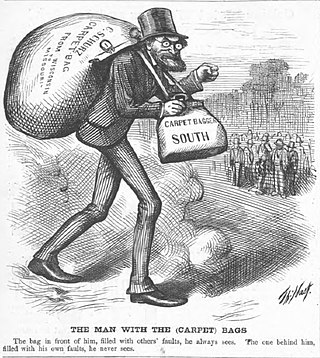
In the history of the United States, carpetbagger is a largely historical pejorative used by Southerners to describe allegedly opportunistic or disruptive Northerners who came to the Southern states after the American Civil War, and were perceived to be exploiting the local populace for their own financial, political, and/or social gain. The term broadly included both individuals who sought to promote Republican politics, and individuals who saw business and political opportunities because of the chaotic state of the local economies following the war. In practice, the term carpetbagger often was applied to any Northerners who were present in the South during the Reconstruction Era (1865–1877). The word is closely associated with scalawag, a similarly pejorative word used to describe native white Southerners who supported the Republican Party-led Reconstruction.
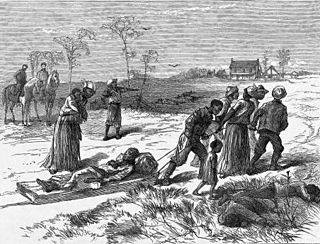
The Colfax massacre, sometimes referred to as the Colfax riot, occurred on Easter Sunday, April 13, 1873, in Colfax, Louisiana, the parish seat of Grant Parish. An estimated 62–153 Black militia men were murdered while surrendering to a mob of former Confederate soldiers and members of the Ku Klux Klan. Three white men also died during the confrontation.
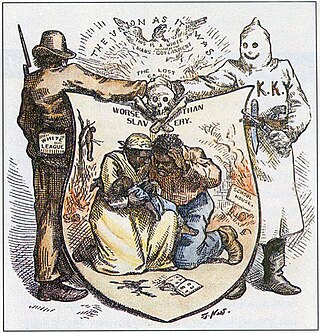
The White League, also known as the White Man's League, was a white supremacist paramilitary terrorist organization started in the Southern United States in 1874 to intimidate freedmen into not voting and prevent Republican Party political organizing, while also being supported by regional elements of the Democratic Party. Its first chapter was formed in Grant Parish, Louisiana, and neighboring parishes and was made up of many of the Confederate veterans who had participated in the Colfax massacre in April 1873. Chapters were soon founded in New Orleans and other areas of the state.
The Redeemers were a political coalition in the Southern United States during the Reconstruction Era that followed the American Civil War. Redeemers were the Southern wing of the Democratic Party. They sought to regain their political power and enforce White supremacy. Their policy of Redemption was intended to oust the Radical Republicans, a coalition of freedmen, "carpetbaggers", and "scalawags". They were typically led by White yeomen and dominated Southern politics in most areas from the 1870s to 1910.
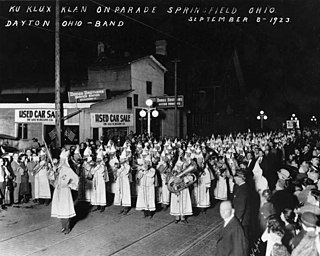
The nadir of American race relations was the period in African-American history and the history of the United States from the end of Reconstruction in 1877 through the early 20th century, when racism in the country, and particularly anti-black racism, was more open and pronounced than it had ever been during any other period in the nation's history. During this period, African Americans lost access to many of the civil rights which they had gained during Reconstruction. Anti-black violence, lynchings, segregation, legalized racial discrimination, and expressions of white supremacy all increased. Asian Americans were also not spared from such sentiments.

John McEnery was a Louisiana Democratic politician and lawyer who was considered by Democrats to be the winner of the highly contested 1872 election for Governor of Louisiana. After extended controversy over election results, the Republican candidate William Pitt Kellogg was certified. McEnery, who had been an officer in the Confederate States Army during the American Civil War, was not allowed to take office following a weighing in by the federal government and local Republicans loyal to President Ulysses S. Grant.
The history of the area that is now the U.S. state of Louisiana, can be traced back thousands of years to when it was occupied by indigenous peoples. The first indications of permanent settlement, ushering in the Archaic period, appear about 5,500 years ago. The area that is now Louisiana formed part of the Eastern Agricultural Complex. The Marksville culture emerged about 2,000 years ago out of the earlier Tchefuncte culture. It is considered ancestral to the Natchez and Taensa peoples. Around the year 800 CE, the Mississippian culture emerged from the Woodland period. The emergence of the Southeastern Ceremonial Complex coincides with the adoption of maize agriculture and chiefdom-level complex social organization beginning in circa 1200 CE. The Mississippian culture mostly disappeared around the 16th century, with the exception of some Natchez communities that maintained Mississippian cultural practices into the 1700s.

The Republican Party of Louisiana(LAGOP) (French: Parti républicain de Louisiane, Spanish: Partido Republicano de Luisiana) is the affiliate of the Republican Party in the U.S. state of Louisiana. Its chair is Louis Gurvich, who was elected in 2018. It is currently the dominant party in the state, controlling all but one of Louisiana's six U.S. House seats, both U.S. Senate seats, all statewide executive offices, and both houses of the state legislature.
The Election Massacre of 1874, or Coup of 1874, took place on election day, November 3, 1874, near Eufaula, Alabama in Barbour County. Freedmen comprised a majority of the population and had been electing Republican candidates to office. Members of an Alabama chapter of the White League, a paramilitary group supporting the Democratic Party's drive to regain political power in the county and state, used firearms to ambush black Republicans at the polls.

The Wheeler Compromise, sometimes known as the Wheeler Adjustment, was the settlement of the disputed gubernatorial election of 1872 in the U.S. state of Louisiana, and negotiation to organize the state's legislature in January 1875. It was negotiated by, and named after, William A. Wheeler, Congressman from New York and a member of the U.S. House Committee on Southern Affairs. He later was elected as Vice President of the United States.
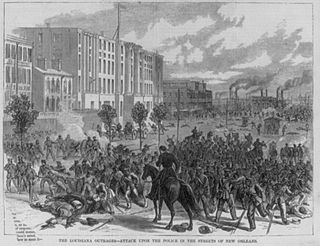
The Battle of Liberty Place, or Battle of Canal Street, was an attempted insurrection and coup d'etat by the Crescent City White League against the Reconstruction Era Louisiana Republican state government on September 14, 1874, in New Orleans, which was the capital of Louisiana at the time. Five thousand members of the White League, a paramilitary terrorist organization made up largely of Confederate veterans, fought against the outnumbered New Orleans Metropolitan Police and state militia. The insurgents held the statehouse, armory, and downtown for three days, retreating before arrival of federal troops that restored the elected government. At least 32 people, including at least 21 Neo-Confederate insurgents, were killed in the fighting. No insurgents were charged in the action.
The civil rights movement (1865–1896) aimed to eliminate racial discrimination against African Americans, improve their educational and employment opportunities, and establish their electoral power, just after the abolition of slavery in the United States. The period from 1865 to 1895 saw a tremendous change in the fortunes of the Black community following the elimination of slavery in the South.
Alexandre Etienne de Clouet, also known as Alexandre Etienne de Clouet, Sr., was an American politician and sugar planter who was active in Louisiana politics both before and after the Civil War. During Reconstruction, he violently opposed Black suffrage, becoming a leader of the violent White League that attacked freedmen who attempted to vote.

George Thompson Ruby was an African-American Republican politician in Reconstruction-era Texas. Born in New York to African-American businessman Reuben Ruby and Rachel Humphey and raised in Portland, Maine, he worked in Boston and Haiti before starting teaching in New Orleans before the end of the American Civil War.
The Opelousas massacre, which began on September 28, 1868, was one of the bloodiest massacres of the Reconstruction era in the United States. In the aftermath of the ratification of Louisiana's Constitution of 1868 and the Fourteenth Amendment to the United States Constitution, tensions between white Democrats and Black Republicans in St. Landry Parish, Louisiana escalated throughout the summer of 1868. On September 28, white schoolteacher and Republican newspaper editor Emerson Bentley was attacked and beaten by three, Democratic white supremacists while teaching a classroom of Black children in Opelousas, Louisiana. Rumors of Bentley's death, while unfounded, led both Black Republicans and white supremacist Democrats, including the St. Landry Parish chapter of the Knights of the White Camelia, to threaten violent retribution. In the days following Bentley's subsequent covert flight to New Orleans, the massacre began. Heavily outnumbered, Black citizens were chased, captured, shot, murdered, and lynched during the following weeks. While estimates of casualties vary widely, several sources number the deaths between 150 and 300 black people and several dozen whites. Following the massacre, the Republican Party in St. Landry Parish was eliminated for several years.
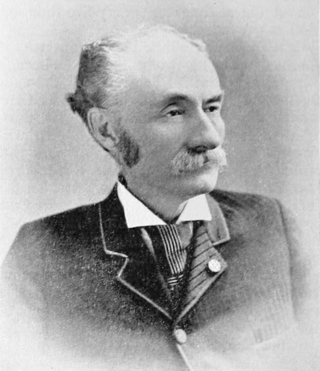
Marshall Harvey Twitchell was a teacher, officer in the Union Army, and businessman. Originally from Vermont, he became a prominent political figure in Louisiana's post-war Reconstruction, including two terms as a Republican member of the Louisiana State Senate. He was seriously wounded during the Civil War and was shot multiple times in an assassination attempt by white supremacists after the war. He returned north, served as a diplomat in Canada, and wrote a memoir.
References
- 1 2 3 4 Danielle Alexander, "Forty Acres and a Mule: The Ruined Hope of Reconstruction", Humanities, January/February 2004, Vol.25/No.1. Her article says 20 freedmen were killed. Archived 2008-09-16 at the Wayback Machine , accessed 14 Apr 2008
- ↑ Nicholas Lemann, Redemption: The Last Battle of the Civil War, New York, Farrar, Straus & Giroux, 2006, p.76-77. His book says five freedmen were killed.
- ↑ Eric Foner, Reconstruction: America's Unfinished Revolution, 1863-1877 , New York: Perennial Classics, 2002, p.550
- ↑ George C. Rable, But There Was No Peace: The Role of Violence in the Politics of Reconstruction, Athens: University of Georgia Press, 1984, p. 132
- 1 2 3 On This Day: The Coushatta Massacre Archived 2016-12-20 at the Wayback Machine , Publishing the Long Civil Rights Movement, UNC at Chapel Hill
- 1 2 3 4 5 Coushatta Massacre Archived 2016-12-20 at the Wayback Machine , Encyclopedia of Louisiana
- 1 2 Eric Foner, Reconstruction: America's Unfinished Revolution, 1863-1877 , New York: Perennial Classics, 2002, p. 551
- ↑ One of the first accounts of the Coushatta masscre is found in Jimmy G. Shoalmire, Carpetbagger Extraordinary: Marshall H. Twitchell, 1840-1905, dissertation at Mississippi State University, Starkville, Mississippi, 1969
- ↑ Nicholas Lemann, Redemption: The Last Battle of the Civil War, New York, Farrar, Straus & Giroux, 2006, p.77.